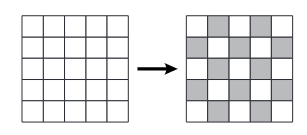The following logical puzzle is mainly inspired by a mathematical contest I went to.
Part A
You are given a cube. How many planes cross this cube by at least 3 vertices? This number will be named $n_{A}$.
Part B
You are given a cube. Here is one of its faces.
$n_{B}$ will be its surface area.
Part C
You are given a 5x5x5 cube with a 25 blank squares grid on each of its 6 faces. Here is an example:
A move on one of its face consists of switching colors of 3 squares in a row — horizontally or vertically — from white to black or from black to white.
$n_{C}$ is the minimum number of moves needed so half of your cube faces is a checkerboard — like in the next diagram — and with the constraint that the total number of black squares in your cube is greater than $n_A+\dfrac{n_{B}}{2}$
Puzzle is to compute $n_C$






